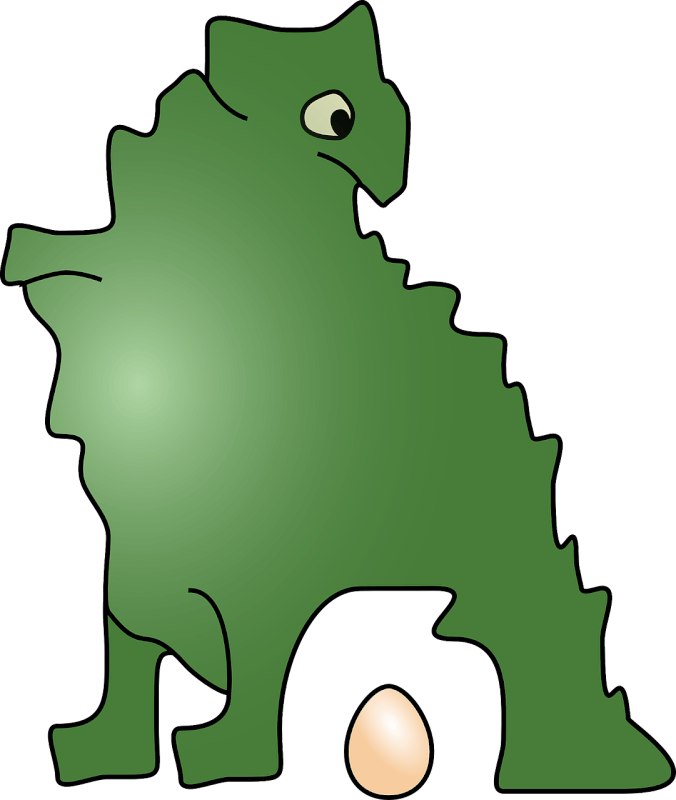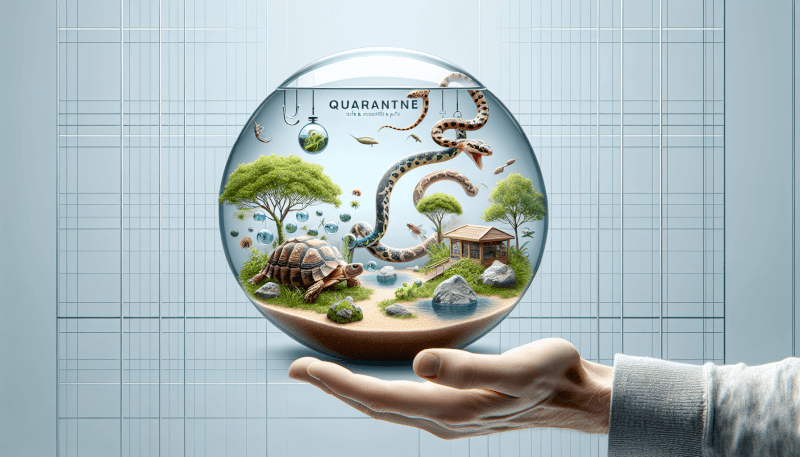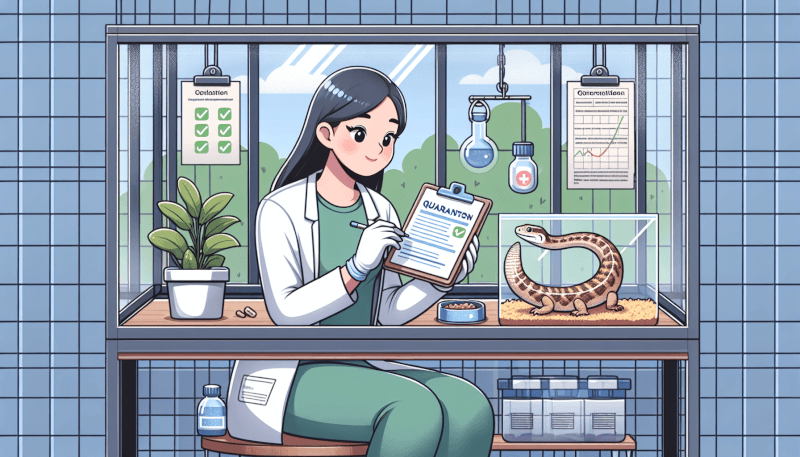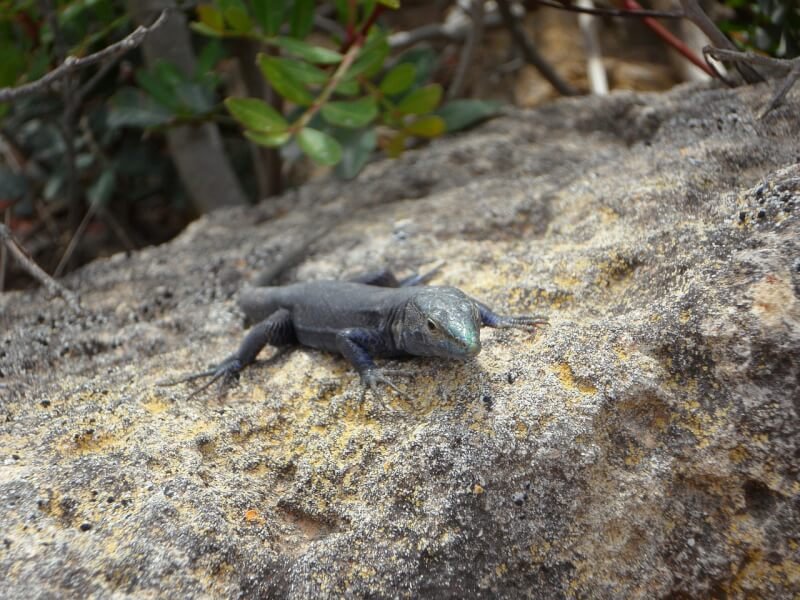So you’ve just brought home a new reptile, and you want to ensure their health and well-being? Quarantining your new scaly friend is the best way to go! By isolating them for a period of time, you can carefully monitor their behavior, detect any potential health issues, and prevent the spread of diseases to your existing reptile collection. In this article, we’ll explore the importance of quarantining new reptiles, the recommended duration for quarantine, and the essential steps to follow for a successful and stress-free isolation period. Get ready to embark on a journey of responsible reptile ownership!

Choosing the Quarantine Setup
Determining the Quarantine Duration
When it comes to quarantining new reptiles, one of the first decisions you need to make is the duration of the quarantine period. This period allows you to observe the reptile for any signs of illness or disease before introducing it to your existing reptile collection. The length of the quarantine period can vary depending on the species and the individual reptile’s health condition. It is generally recommended to quarantine the new reptile for a minimum of 30 days to ensure its overall well-being.
Selecting a Suitable Quarantine Enclosure
Another crucial aspect of setting up a successful quarantine is selecting an appropriate enclosure. The enclosure should be spacious enough for the reptile to move around comfortably, with sufficient hiding spots for security and privacy. It is important to choose an enclosure that is easy to clean and sanitize, as this will aid in preventing the spread of any potential illnesses. Make sure the enclosure has proper ventilation to ensure the reptile’s respiratory health. Consider housing the reptile in a plastic or glass enclosure, as they are easier to maintain and sterilize compared to wooden enclosures.
Providing the Right Temperature and Humidity Levels
Reptiles have specific temperature and humidity requirements, and it is essential to replicate their natural environment in your quarantine setup. Invest in a high-quality thermometer and hygrometer to monitor the temperature and humidity levels accurately. Different reptile species have varying temperature and humidity preferences, so it is important to research and understand the specific needs of the reptile you are quarantining. You may need to use heating pads, heat lamps, or misting systems to maintain the ideal temperature and humidity ranges. Consistency is key, as sudden changes in temperature or humidity can stress the reptile and compromise its health.
Quarantine Location
Isolating the New Reptile from Other Pets
During the quarantine period, it is crucial to keep the new reptile separate from your existing pets. This prevents cross-contamination and reduces the risk of spreading any potential diseases. Choose a separate room or area in your home to house the quarantined reptile, away from your other pets. This isolation ensures that if the reptile does carry any illnesses, it will not be transmitted to your other animals. Be sure to thoroughly clean and disinfect the area before and after quarantine to maintain a safe and hygienic environment.
Creating a Stress-free Environment
Reptiles are sensitive to stress, and the quarantine period can be a particularly stressful time for them. It is essential to create a calm and stress-free environment to promote their overall well-being. Provide hiding spots, such as caves or branches, to give the reptile a sense of security. Avoid excessive handling or sudden loud noises, as these can cause unnecessary stress. Keep the lighting in the enclosure dim to mimic the reptile’s natural habitat. Limit human interaction to minimal disturbance, allowing the reptile to settle and acclimate to its new surroundings.

Health Assessment
Observing the Reptile’s Behavior
During the quarantine period, closely observe the behavior of the new reptile. Look for any signs of abnormal behavior such as lethargy, lack of appetite, excessive aggression, or excessive hiding. These behaviors could indicate potential health issues or stress. Note any changes in behavior and consult a veterinarian if necessary. Keep a log or journal to record the reptile’s behavior patterns, which will aid in spotting any concerning patterns or trends.
Checking for Signs of Illness or Disease
Regularly check for any visible signs of illness or disease in the quarantined reptile. Look for abnormal skin lesions, discharge from the eyes or nose, or any signs of respiratory distress. Pay attention to the reptile’s overall appearance, including its body condition, coloration, and the presence of parasites. If you notice any concerning signs, it is important to contact a veterinarian immediately for a professional evaluation. Early detection and treatment of illnesses can significantly increase the chances of recovery.
Performing a Physical Examination
Performing a thorough physical examination is an essential part of the quarantine process. Carefully handle the reptile and conduct a visual examination of its body. Check for any external parasites, such as mites or ticks, and inspect the skin for abnormalities. Gently palpate the reptile’s body to check for any lumps, bumps, or swelling. Inspect the oral cavity for any lesions or signs of infection. If you have any concerns or are unsure how to conduct a physical examination, it is best to consult a veterinarian for assistance.
Quarantine Procedures
Handling the New Reptile Safely
When handling the new reptile during the quarantine period, it is important to prioritize safety for both you and the reptile. Use appropriate handling techniques and tools to minimize stress and prevent potential injuries. Some reptiles may be more prone to biting or scratching when they feel threatened, so it is essential to handle them with care. Wear protective gloves if necessary, and avoid sudden movements or loud noises that may startle the reptile. Proper handling techniques will minimize stress for the reptile and reduce the risk of any accidents or injuries occurring.
Following Proper Hygiene Practices
Maintaining good hygiene practices is critical in preventing the spread of diseases or parasites during the quarantine period. Before and after handling the reptile, always wash your hands thoroughly with warm water and antibacterial soap. Use separate tools and equipment for each reptile to avoid cross-contamination. Regularly clean and disinfect the quarantine enclosure and any accessories used in the reptile’s habitat. By following proper hygiene practices, you are ensuring the well-being of the reptile and minimizing the risk of infections or diseases.
Feeding and Watering the Reptile
Proper nutrition and hydration are vital for the reptile’s health. Research and understand the specific dietary requirements of the reptile species you are quarantining. Provide a balanced and varied diet consisting of commercially available reptile food, supplemented with appropriate fresh fruits, vegetables, and insects. Ensure that the food is appropriate in size and easily digestible for the reptile. Fresh, clean water should always be available in a shallow bowl or dish. Monitor the reptile’s feeding habits and keep a record of its food intake to ensure it is receiving an adequate diet while in quarantine.

Monitoring and Record-keeping
Regular Health Checks
Throughout the quarantine period, it is important to conduct regular health checks to monitor the reptile’s overall well-being. Observe its behavior, appetite, and physical appearance on a daily basis. Keep a record of these observations to track any changes or emerging patterns. Monitoring the reptile’s health regularly allows you to quickly identify any potential issues and take appropriate action promptly.
Recording Behavior and Condition
Keeping accurate records of the reptile’s behavior and condition is an essential part of the quarantine process. Document any changes in behavior, appetite, or physical appearance. Note any treatment administered, such as medication or parasite control. Maintain a daily log of the reptile’s activities, including eating, drinking, shedding, and defecating. These records will not only help you recognize any health concerns but will also provide valuable information to veterinarians should the need arise for professional consultation.
Consulting a Veterinarian
While regular monitoring and record-keeping are essential, there may be instances where professional assistance is necessary. If you have any concerns about the reptile’s health or behavior during the quarantine period, do not hesitate to seek veterinary advice. Reptile veterinarians have the expertise and experience to diagnose and treat diseases specific to reptiles. A veterinarian can guide you in the proper protocols for quarantine and help address any health concerns that may arise.
Veterinary Consultation
Seeking Professional Advice
If you are new to reptile keeping or have any uncertainties during the quarantine period, it is always a good idea to seek professional advice from a reptile veterinarian. They can provide guidance on the best practices for quarantine and offer recommendations tailored to your specific reptile’s needs. Consulting with a reptile veterinarian early on can prevent potential health issues and ensure you are providing optimal care for the reptile.
Testing for Parasites and Diseases
A reptile veterinarian can conduct specialized tests to identify and treat any potential parasites or diseases that the quarantined reptile may be harboring. They may perform fecal examinations to check for internal parasites or take swabs to test for bacterial or viral infections. By identifying and treating these health issues promptly, you can prevent the spread of diseases to other reptiles in your collection and ensure the overall well-being of the quarantined reptile.
Addressing Any Health Concerns
In the event that a reptile in quarantine exhibits signs of illness or disease, a veterinarian can provide the necessary treatments and medications. They will be able to prescribe appropriate medications and provide guidance on their administration. Addressing any health concerns promptly and effectively is vital not only for the well-being of the reptile but also to maintain the health and integrity of your entire reptile collection.

Gradual Introduction to the Main Enclosure
Quarantine Completion Criteria
Before transitioning the quarantined reptile to its permanent enclosure, certain criteria must be met to ensure it is healthy and free from any potential diseases. Ideally, the reptile should have completed the designated quarantine period without any signs of illness or disease. It should have maintained a healthy appetite, normal behavior, and exhibited no external signs of parasites or infections. Additionally, consulting with a reptile veterinarian and performing any necessary tests can provide further assurance that the reptile is safe to be introduced to the main enclosure.
Maintaining Separate Habitats
Even after the quarantine period is complete and the reptile is deemed healthy, it is important to maintain separate habitats for different reptiles. This precautionary measure helps prevent the potential spread of parasites, diseases, or infections between the reptiles. Each reptile should have its own designated enclosure, with individual equipment and accessories. By keeping the habitats separate, you can minimize the risk of cross-contamination and maintain the overall health of your reptile collection.
Slowly Introducing the Reptile to Its Permanent Enclosure
When introducing the quarantined reptile to its permanent enclosure, it is essential to do so gradually. The reptile may have become accustomed to the quarantine enclosure, and sudden changes can cause stress. Start by placing the reptile’s new enclosure next to the quarantine enclosure, allowing it to observe and acclimate to its future surroundings. Over the course of several days, gradually move the reptile to its new enclosure, providing a smooth transition. Monitor its behavior and well-being closely during this time to ensure a successful integration into its permanent habitat.
Handling the Reptile After Quarantine
Properly Washing Hands
After handling the quarantined reptile or any reptile-related equipment, always remember to wash your hands thoroughly. This simple yet crucial step helps prevent the potential transmission of any diseases or parasites between reptiles or to yourself. Use warm water and antibacterial soap, ensuring you wash your hands for at least 20 seconds. Proper hand hygiene is essential for maintaining a safe and healthy environment for both you and your reptiles.
Minimizing Stress during Handling
Reptiles can easily become stressed when handled improperly, affecting their overall health and well-being. When handling a reptile, make sure to approach it calmly and confidently. Avoid making sudden movements or loud noises that may startle the reptile. Support the reptile’s body properly to prevent any injuries. Keep handling sessions brief and infrequent to minimize stress. Reptiles are generally more comfortable being observed from a distance, so limiting handling to essential tasks such as health checks or cleaning will help reduce stress levels.
Taking Precautions with Other Pets
When handling a reptile, it is important to consider the well-being of other pets in your household as well. Some animals may have a predatory instinct towards reptiles, which can lead to accidents or injuries. Always supervise interactions between pets and reptiles closely, and never leave them unattended together. Secure the reptile’s enclosure to prevent other pets from gaining access. By taking necessary precautions, you can ensure the safety of all your pets and maintain a harmonious environment.

Preventative Measures
Disinfecting Quarantine Equipment
Proper disinfection of quarantine equipment is crucial to prevent the potential transmission of diseases or parasites. After the quarantine period, thoroughly clean and disinfect all equipment used in the reptile’s habitat. Use reptile-specific disinfectants that are safe and effective against reptile pathogens. Scrub the enclosures, accessories, and utensils with hot water and the recommended disinfectant, ensuring all surfaces are adequately treated. Allow the equipment to dry completely before reintroducing the reptile or using it for another reptile in quarantine.
Implementing Biosecurity Measures
Maintaining biosecurity measures not only safeguards the health of your reptiles but also helps prevent the introduction and spread of diseases within your collection. Implementing strict biosecurity practices includes washing hands before and after handling reptiles, using separate equipment for each reptile, and ensuring proper cleaning and disinfection protocols are followed. Biosecurity measures are particularly important when attending reptile shows, visiting other reptile collections, or adding new reptiles to your collection.
Quarantining All New Reptiles
Quarantining all new reptiles is a crucial step in ensuring the health and well-being of your reptile collection. Regardless of the source or apparent health of the reptile, it is advisable to quarantine all new additions before introducing them to your existing reptiles. This precautionary measure allows you to thoroughly observe and evaluate the new reptile’s health status, reducing the risk of disease transmission. By consistently quarantining new reptiles, you are actively protecting the overall health of your entire collection.
Professional Assistance
Engaging with Reptile Experts
Engaging with reptile experts can provide invaluable knowledge and support throughout the quarantine process and beyond. Reptile experts, such as breeders, experienced keepers, or reptile organizations, can offer guidance on best practices, answer specific questions, and provide recommendations tailored to your reptile’s needs. Utilize online forums and social media groups dedicated to reptile keeping to connect with these experts and tap into their extensive knowledge.
Joining Reptile Enthusiast Communities
Joining reptile enthusiast communities can provide a wealth of information and a supportive network of fellow reptile keepers. These communities often host regular discussions, offer advice and tips, and share personal experiences. By participating in these communities, you can gain insights into successful quarantine practices, learn about common health concerns, and build connections with like-minded individuals who share your passion for reptiles.
Attending Herpetological Society Meetings
Attending herpetological society meetings or reptile-related events can be an excellent way to expand your knowledge and network with other reptile enthusiasts. These gatherings often feature educational presentations, workshops, and exhibitions where you can learn from seasoned experts in the field. By actively participating in herpetological society meetings, you can stay up to date with the latest research and advancements in reptile care and further enhance your reptile-keeping skills.
In conclusion, establishing a proper quarantine setup for new reptiles is essential for maintaining the health and well-being of your entire reptile collection. Through careful planning and execution, you can create a stress-free environment, conduct thorough health assessments, and implement effective quarantine procedures. By consulting with veterinarians, following proper hygiene practices, and gradually introducing the reptile to its permanent enclosure, you ensure the success of the quarantine period. Remember to handle the reptile after quarantine with care, minimize stress, and take necessary precautions with other pets. Implementing preventative measures and seeking professional assistance when needed are crucial for the long-term health of your reptiles. By following these guidelines and actively engaging with reptile experts and communities, you can provide optimal care and create a safe and thriving reptile habitat.


